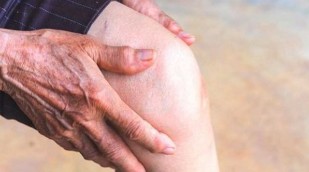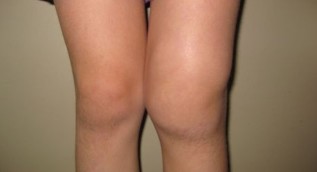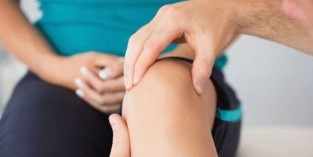Osteoarthritis of the knee joint (gonarthrosis) is a disease that is characterized degenerative diseases-degenerative changes in the articular cartilage, menisci, and then the bones that form the knee joint. The disease, which occupies a leading place among the diseases of the musculoskeletal system.

The causes of gonarthrosisa
Osteoarthritis of the knee is a polyetiological disease, that is, in this state, if the development of pathological alterations contributes to various causal factors. In this case, talking about the primary (idiopathic) osteoarthritis. When the secondary gonarthrosise is the exact factor that has caused the disease.
The main reason for osteoarthritis is:
- an injury to the knee;
- surgical intervention in the area of the knee joint;
- the increase in physical stress;
- the excess of weight, obesity.
- a congenital disorder of the lower extremities;
- the syndrome of the system and the connective tissue dysplasia;
- a violation of the metabolism;
- the general diseases (diabetes mellitus, rheumatoid arthritis, acromegaly).
Important!
The impact of the traumatic agent, it is the main cause of osteoarthritis at a young age. Injuries to the knee joint, which causes the arthritis, include dislocations, fractures, or any damage to the meniscus.
On the basis of the development of the pathological changes is the need for the mobilization of the joint following injury, contribute to the deterioration of the blood circulation in periarticular tissues, along with the damage mechanic takes the time to wound healing and the development of signs of arthritis.
The increase in physical stress manifests itself not only in intense exercise classes, but also in the presence of an excess of weight. Lose weight and exercise, they do not correspond to the age and level of physical fitness of a person, leading to the appearance of micro-fissures in the articular cartilage or the menisci, which is the first stage in the process of the formation of the gonarthrosisa.
A congenital disorder of the lower extremities, which refer to shortening of one of the members, and dysplasia, as well as valgus or varus deformation of the feet, leads to the onset of arthritis due to the uneven distribution of the weight of the person. As a result, the cartilage wears off, is made up of a nursery for the aseptic inflammation with the appearance of clinical signs characteristic of osteoarthritis.
The syndrome of the system and the connective tissue dysplasia, is characterised by hyper-mobility, and of the insufficiency of the ligamentous apparatus. Resulting in a joint, increase range of motion, even pathological. This instability, which quickly leads to the onset of the trauma to the meniscus and on the articular surface of the articular cartilage.
The disturbance of metabolism, and the availability of the total somatic pathology, causes and development of osteoarthritis is due to disturbances in the microcirculation of the knee joint, decreasing the nutrition to the articular cartilage and the menisci, damage to the composition of the intra-articular fluid.
Rating
Code-ICD 10 – M17. Depending on the etiological factor in the formation of arthritis include the following categories:
- M17.0 primary gonarthrosis, two-way;
- M17.1 – the other primary gonarthrosis;
- M17.2 post-traumatic gonarthrosis in two ways;
- M17.3 other post-traumatic gonarthrosis;
- M17.4 other secondary gonarthrosis, double sided;
- M17.5 other secondary gonarthrosis;
- M17.9 – gonarthrosis does not control.

Include the following types of osteoarthritis of the knee:
- the involution is due to a change in the body, disorders of the metabolism of the wear on the articular surfaces of the bones;
- dysplastic – that is, associated with defects and anomalies of the lower limbs;
- post-traumatic stress disorder;
- metabolic-occurs when the common diseases that involve a metabolic disorder (gout, chondrocalcinosis);
- dishormonal, is seen as the hormonal imbalance in the body when diabetes, menopause, abnormalities of the thyroid gland;
- then, an inflammatory process takes place after infectious-inflammatory diseases of the knee joint;
- static is seen as the excessive physical exertion, unhealthy distribution of weight, and obesity.
- ischemic stroke – this involves a breach of the supply of blood to the knee area.
The pathogenesis
The disease develops gradually. First of all, the changes will appear in the Podhradie-layer – formed fractures and capillaries. The emergence of micro-cracks, and fire in the ongoing work of the knee-joint, is one of the functions is the depreciation of the bumps when you walk. And, if you have the etiological factors of stress on the knee joint increases, and the process of destruction begins to exceed the recovery process of the tissue of the cartilage, resulting in a crack to appear.
Later, in the fractures and the hair penetrates the synovial fluid and form cysts that have a tendency to increase, and the company. The great the cysts begin to tighten and the blood vessels feeding the cartilage, resulting in the starvation of oxygen to the tissue of the articular cartilage. They are to be violated, and all the metabolic processes, reduces the synthesis of collagen and is necessary for the recovery of the cartilage. Given the poor recovery of the articular cartilage, there is a gradual in its removal, which leads to the impairment of the function of the joint, appear the clinical signs of the disease.
Note!
When the progression begins to form bone spurs proliferation of bone. Bone spurs most of them located on the edges of the articular surfaces of the bones. Their presence provokes an inflammatory response in the joint, pain, and deformity of the joint, a serious limitation of mobility.
With the development of an inflammatory process that can occur is the swelling of tissues, leading to an increase in the pressure in the joint, the deterioration in the composition of the intra-articular fluid, it is broken down in the nourishment of the articular cartilage.
The clinical symptoms
In the course of the disease include various degrees of arthritis, and reflect on the process and progress of pathological changes, and they have certain clinical manifestations.
The symptoms of osteoarthritis of the knee, making the break on stages:
- In the early stage of the disease is characterized by the appearance of pain in the region of the knee, especially after an intense workout or a prolonged stay on the feet. The least favorable static charging, namely, the lifting of the weight. The pain in the joint it passes on its own after you leisure. In addition to the pain, it can appear wrinkled or click on a collection, which indicates the violation of the congruence of the articular surfaces of the bones that comprise the joint, and the appearance of micro-cracks in the cartilage. The lack of sharply expressed by the clinical evidence leads to the fact that the vast majority of patients do not seek medical help at an early stage, which leads to a later diagnosis.
- The progression of the disease leads to the formation of more pronounced and the starting point of the pain syndrome, pain may occur even after you have a light load, by itself, it doesn't work. You get in the morning stiffness in joints lasting for about 30 minutes, but if the joint inflammation, stiffness, can last for up to 1 hour. Because he expresses the pain that a person begins to save, the leg, the decrease in the amplitude of the motion, appears, limping. Due to the swelling of the tissues of the knee increase in volume. Appear on the signs of radiological osteoarthritis of the knee.
- The appearance of bone spurs characterize the development of stage 3 of the disease, which is highly expressed in the pain that is caused, even at rest, the evil jugulate of the drug. The movement is almost non-existent, with the joint formed. Is it possible to lock the knee joint in a particular position, as well as strains, sprains or subluxations.

Diagnostic tests
The diagnosis of osteoarthritis is the sum of several components:
- The complaints of the patient.
- The history of the development of the disease.
- The story of the life of the patient as well.
- In the laboratory, and the instrumentation and methods of research.
On the basis of complaints of the patient, as well as the story of the life and the illness of the physician, sets out the pre-assessment. But for carrying out a differential diagnosis with other pathologies, and to establish a diagnosis, it is necessary to carry out in the laboratory and in the implementation of the methods.
The instrumental methods a survey of the articulation of the knee include the following:
- the x-ray;
- arthroscopy;
- the ct scan;
- an examination of the ultra-sound;
- the magnetic resonance imaging.
Important!
The main method of diagnosis of arthritis, it is an examination of the x-rays. an x-ray image of the knee joint is made in two sizes, which gives you a complete picture of the available over the changes. It is important to note that in the early stages of osteoarthritis in the picture doesn't.
Based on the issues identified by the x-ray signal is constructed by the x-ray classification of gonarthrosisa:
- 1, the grade is a little closer to the articular slot;
- 2 grade – is a little closer to the slot joint, and the presence of bone marrow of the seal;
- The 3-rank is expressed by a narrowing of the crack and joint, and the presence of osteophytes, and the signs of deformation in the bone;
- 4th grade is expressed by a narrowing of the joint cleft to the complete absence of several bone spurs, and destruction of the osseous tissue, the deformity of the joint.
Other methods, such as withdrawal of the joint of the knee is an add-on to the core of the x-ray survey. And is held how to diagnose, more difficult to establish the diagnosis.
Each and every one of the analysis methods has its indications, contra-indications, and a different value, therefore, necessarily, have to be assigned to a specialist if need be.
How to treat osteoarthritis of the knee
For the treatment of osteoarthritis of the knee should start as soon as the first clinical signs of the disease. The modern treatment of osteoarthritis of the knee aims to restore the function of the joint, and improve the quality of life of the patient, and is as follows:
- interruption, or reduction, of pain.
- the treatment of the inflammatory process;
- the restoration of the structure of the cartilage;
- the increase in the amplitude of the motion;
- to improve the microcirculation of the periarticular tissues.

Note! It is important to note that the different stages are applied to different types of treatment. If this were the case you begin to deal with the disease, and then you can get rid of not only pain, but also to recover from the knee joint when osteoarthritis, as well as to minimize the risk of complications.
Is applied in the therapy of the drug helps to reduce pain and the inflammatory response, which is achieved by the application of a non-steroidal anti-inflammatory drugs. For the repair of articular cartilage are attributed to chondroprotector. The treatment plan is created and monitored by a medical doctor.
In addition to medical treatment, are assigned to one physical therapy, topical ointments, exercise, massage therapy, or intra-articular injection of the drug.
Do you treat osteoarthritis of the knee
In such a case, the acceptance of items that you can bring into or take out a pad. In folk medicine, it should not be administered as a single agent, and to be a part of a more complex processing of the events. Prior to the start of the treatment is similar to that in the house, you should be familiar with the recommendations of, and comments on it.
Is there a treatment for osteoarthritis
Notice the use of improper or delayed treatment for the effects of the progression of the disease, do not wait. Gonarthrosis is dangerous due to the fact that, even with the correct treatment, you can't stop the process, only slows it down, but it allows for a one-of-a-time, to maintain the activity.
If the disease has reached the worst phase, the conventional treatment becomes ineffective. During phase 3, go to the surgical treatment, after which it is necessary a long rehabilitation.




























